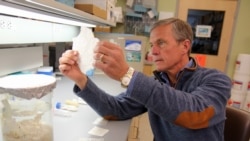The ability to regenerate or recreate missing body parts sounds more like part of a science fiction story than reality.
But researchers are finding evidence that regeneration may be possible someday in the future with improvements in technology. They imagine using 3D-printing to make a kidney for someone in need of a replacement. They also talk about possibly using bioelectricity to cause cells to build new tissue and organs.
These ideas and others were discussed earlier this month at the World Science Festival in New York City. The presentation was called “Forever Young: The Promise of Human Regeneration.”
Scientists talked about the future of regenerative medicine, which combines the body’s ability to heal itself with progress in biomedical engineering.
Dany Spencer Adams is a research professor at Tufts University in Massachusetts. He told VOA that researchers have found that bioelectrical signals can lead to cellular processes in frog tadpoles. He said such signals may someday start the formation of nerves, muscles and other body parts.
“This is the cells themselves using electricity to communicate,” he said.
In an experiment, a frog re-grew one of its legs in six months. But scientists first had to make changes in the characteristics of the animal’s cells.
Researchers say they have a lot more work to do before the process can be used on human beings. They have to learn which bioelectric signals can influence the formation of which organs.
Adams says “it’s better to regenerate that organ so that you don’t have issues of the immune system attacking, the way we do now with transplants. The hope is that we’ll be able to help the body create a better replacement -- really, a perfect replacement, for the person of exactly what they’ve lost.”
Jonathan Butcher is a professor and biomedical engineer at Cornell University in New York. He and other researchers have combined mechanical engineering with developmental biology to create working heart valves from 3D-printed tissue.
Children may get the most help from engineered organs or partial organs that can grow as the child does.
I’m Anne Ball.
VOA’s Tina Trinh reported this story from New York. Christopher Jones-Cruise adapted her report for Learning English. George Grow was the editor.
We want to hear from you. Write to us in the Comments Section, or visit our Facebook page.
_______________________________________________________________
Now, test your understanding with this short quiz.
_______________________________________________________________
Words in This Story
science fiction – n. stories about how people and societies are affected by imaginary scientific developments in the future
3-D – n. made in a way that causes an image to appear to be three-dimensional
characteristic – n. typical of a person, thing, or group : showing the special qualities or traits of a person, thing, or group
immune system – n. the system that protects your body from diseases and infections
transplant – n. an organ, piece of skin, etc., that is transplanted









